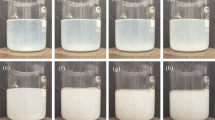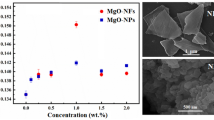Abstract
The main goal of this study is to improve the dispersion stability of Al2O3 nanoparticles in polyalphaolefin oil to overcome the sedimentation problem of nanoparticles using the addition of oleic acid as a surfactant. Based on the previous single or insufficient research on the preparation conditions of nanolubricating oil, the effects of temperature, ultrasonic duration, ultrasonic power, and nanoparticle/surfactant (oleic acid) concentration on the dispersion stability of Al2O3 nanoparticles (size range of about 50nm) in oil-based solutions were systematically and comprehensively studied in this work. Herein, the preparation conditions were optimized and the stable nanofluids were obtained. The visual observation, UV–Vis spectroscopy, and dynamic light scattering (DLS) analysis were used to evaluate the dispersion stability of the Al2O3 nanoparticles. Moreover, the dispersion state of Al2O3 in PAO6 solution was demonstrated through transmission electron microscopy (TEM) and Fourier transform infrared (FTIR) at a microscopic level, and the mechanism of dispersion stability was analyzed. The results reveal that the thermal method during the synthesis of nanofluids using 50°C temperature improves the dispersion of nanoparticles. The results also exhibited that there is an optimal match between the ultrasonication power and the ultrasonication duration during the synthesis of nanofluids, which affects its dispersion stability. The results showed that 0.4%wt% oleic acid was needed for the nanolubricants containing 0.005wt% and 0.01wt% to achieve excellent dispersion stability, and the stabilization time exceeds 160 days.
Graphical abstract








Similar content being viewed by others
References
Abdullah M, Malik SR, Iqbal MH, Sajid MM, Shad NA, Hussain SZ, Razzaq W, Javed Y (2018) Sedimentation and stabilization of nano-fluids with dispersant. Colloids Surf A Physicochem Eng Asp 554:86–92
Ali MKA, Hou XJ (2020) Improving the heat transfer capability and thermal stability of vehicle engine oils using Al2O3/TiO2 nanomaterials. Powder Technol 363:48–58
Ali MKA, Hou XJ, Elagouz A, Essa FA, Abdelkareem MAA (2016a) Minimizing of the boundary friction coefficient in automotive engines using Al2O3 and TiO2 nanoparticles. J Nanopart Res 18:377
Ali MKA, Hou XJ, Mai LQ, Cai QP, Turkson RF, Chen BC (2016b) Improving the tribological characteristics of piston ring assembly in automotive engines using Al2O3 and TiO2 nanomaterials as nano-lubricant additives. Tribol Int 103:540–554
Ali MKA, Hou XJ, Turkso RF, Peng Z, Chen XD (2016c) Enhancing the thermophysical properties and tribological behaviour of engine oils using nano-lubricant additives. RSC Adv 6:77913–77924
Ali MKA, Peng FM, Younus HA, Abdelkareem MAA, Essae FA, Elagouz A, Hou XJ (2018a) Fuel economy in gasoline engines using Al2O3/TiO2 nanomaterials as nanolubricant additives. Appl Energy 211:461–478
Ali MKA, Hou XJ, Essa FA, Abdelkareem MAA, Elagouz A, Sharshir SW (2018b) Friction and wear reduction mechanisms of the reciprocating contact interfaces using nanolubricant under different loads and speeds. J Tribol 140:051606
An JW, You DH, Lim DS (2003) Tribological properties of hot-pressed alumina–CNT composites. Wear 255:677–681
Anand K, Siby V (2017) Role of surfactants on the stability of nano-zinc oxide dispersions. Part Sci Technol 35:67–70
Asnida M, Hisham S, Awang NW, Amirruddin AK, Noor MM, Kadirgama K, Ramasamy D, Najafi G, Tarlochan F (2018) Copper (II) oxide nanoparticles as additive in engine oil to increase the durability of piston-liner contact. Fuel 212:656–667
Assael MJ, Metaxa IN, Arvanitidis J, Christofifilos D, Lioutas C (2005) Thermal conductivity enhancement in aqueous suspensions of carbon multi-walled and double-walled nanotubes in the presence of two different dispersants. Int J Thermophys 26. https://doi.org/10.1007/s10765-005-5569-3
Awang NW, Ramasamy D, Kadirgama K, Samykano M, Najafi G, Sidik NAC (2019) An experimental study on characterization and properties of nano lubricant containing cellulose nanocrystal (CNC). Int J Heat Mass Transf 130:1163–1169
Battez AH, Gonzàlez JLR, Viesca JE, Fernàndez JM, Fernàndez D, Machadoc A, Choud JRR (2008) CuO, ZrO2 and ZnO nanoparticles as antiwear additive in oil lubricants. Wear 265:422–428
Choi C, Yoo HS, Oh JM (2008) Preparation and heat transfer properties of nanoparticle-in-transformer oil dispersions as advanced energy-efficient coolants. Curr Appl Phys 8:710–712
Chou R, Battez AH, Cabello JJ, Viesca JL, Osorio A, Sagastume A (2010) Tribological behavior of polyalphaolefin with the addition of nickel nanoparticles. Tribol Int 43:2327–2332
Elagouz A, Ali MKA, Hou XJ, Abdelkareem MAA, Hassan MA (2020) Frictional performance evaluation of sliding surfaces lubricated by zinc-oxide nano-additives. Surf Eng 36:144–157
Esfe MH, Arani AAA, Esfandeh S, Afrand M (2019) Proposing new hybrid nano-engine oil for lubrication of internal combustion engines: Preventing cold start engine damages and saving energy. Energy 170:228–238
Ghadimi A, Metselaar IH (2013) The influence of surfactant and ultrasonic processing on improvement of stability, thermal conductivity and viscosity of titania nanofluid. Exp Thermal Fluid Sci 51:1–9
Ghadimi A, Saidur R, Metselaar HSC (2011) A review of nanofluid stability properties and characterization in stationary conditions. Int J Heat Mass Transf 54:4051–4068
Graves JE, Sugden M, Litchfield RE, Hutt DA, Mason TJ, Cobley AJ (2016) Ultrasound assisted dispersal of a copper nanopowder for electroless copper activation. Ultrason Sonochem 29:428–438
Guo JX, Barber GC, Schall DJ, Zou Q, Jacob SB (2017) Tribological properties of ZnO and WS2 nanofluids using different surfactants. Wear 382:8–14
Hong R, Li J, Zhang S, Li H, Zheng Y, Ding J, Wei D (2009) Preparation and characterization of silica-coated Fe3O4 nanoparticles used as precursor of ferrofluids. Appl Surf Sci 255:3485–3492
Jiao D, Zheng S, Wang Y, Guan R, Cao B (2011) The tribology properties of alumina/silica composite nanoparticles as lubricant additives. Appl Surf Sci 257:5720–5725
Joly-Pottuz L, Vacher B, Ohmae N (2008) Anti-wear and friction reducing mechanisms of carbon nano-onions as lubricant additives. Tribol Lett 30:69–80
Kabir ME, Saha MC, Jeelani S (2007) Effect of ultrasound sonication in carbon nanofibers/polyurethane foam composite. Mater Sci Eng A 459:111–116
Kole M, Dey TK (2011) Effect of aggregation on the viscosity of copper oxide–gear oil nanofluids. Int J Therm Sci 50:1741–1747
Kole M, Dey TK (2013) Enhanced thermophysical properties of copper nanoparticles dispersed in gear oil. Appl Therm Eng 56:45–53
Koshy CP, Rajendrakumar PK, Thottackkad MV (2015) Evaluation of the tribological and thermo-physical properties of coconut oil added with MoS2 nanoparticles at elevated temperatures. Wear 330:288–308
Laura PP, Jaime TT, Lorena G, Demófilo MC, Remigiusz M, Carolina L (2015) Effect of CuO and Al2O3 nanoparticle additives on the tribological behavior of fully formulated oils. Wear 332:1256–1261
Li W, Zheng SH, Cao BQ, Ma SY (2010) Friction and wear properties of ZrO2/SiO2 composite nanoparticles. J Nanopart Res 13:2129–2137
Lin CY, Wang JC, Chen TC (2011) Analysis of suspension and heat transfer characteristics of Al2O3 nanofluids prepared through ultrasonic vibration. Appl Energy 88:4527–4533
Liñeira JM, López ER, Fernández J, García F (2019) Tribological properties of dispersions based on reduced graphene oxide sheets and trimethylolpropane trioleate or PAO 40 oils. J Mol Liq 274:568–576
LotfizadehDeh B, Kazi SN, Hamdi M, Ghadimi A, Sadeghinezhad E (2013) Investigation of viscosity and thermal conductivity of alumina nanofluids with addition of SDBS. Heat Mass Transf 49:1109–1115
Luo T, Wei XW, Huang X, Huang L, Yang F (2014) Tribological properties of Al2O3 nanoparticles as lubricating oil additives. Ceram Int 40:7143–7149
Mahbubul IM, Saidur R, Amalina MA, Elcioglu EB, Okutucu-Ozyurt T (2015) Effective ultrasonication process for better colloidal dispersion of nanofluid. Ultrason Sonochem 26:361–369
Mahbubul IM, Elcioglu EB, Saidur R, Amalina MA (2017) Optimization of ultrasonication period for better dispersion and stability of TiO2-water nanofluid. Ultrason Sonochem 37:360–367
Mahdavian AR, Sarrafi Y, Shabankareh M (2009) Nanocomposite particles with core–shell morphology III: Preparation and characterization of nano Al2O3–poly(styrene–methyl methacrylate) particles via miniemulsion polymerization. Polym Bull 63:329–340
Meng Y, Su FH, Chen YZ (2017) Au/graphene oxide nanocomposite synthesized in supercritical CO2 fluid as energy efficient lubricant additive. ACS Appl Mater Interfaces 9:39549–39559
Mohan N, Sharma M, Singh R, Kumar N (2014) Tribological properties of automotive lubricant SAE 20W-40 containing nano-Al2O3 particles, SAE Technical Paper Series
Nguyen VS, Rouxel D, Hadji R, Vincent B, Fort Y (2011) Effect of ultrasonication and dispersion stability on the cluster size of alumina nanoscale particles in aqueous solutions. Ultrason Sonochem 18:382–388
Nguyen VS, Rouxel D, Vincent B (2014) Dispersion of nanoparticles: From organic solvents to polymer solutions. Ultrason Sonochem 21:149–153
Pishvaei M, Tabrizi FF (2010) Synthesis of high solid content polyacrylate/nanosilica latexes via miniemulsion polymerization. Iran Polym J 19:707–716
Rajendhran N, Palanisamy S, Periyasamy P, Venkatachalam R (2018) Enhancing of the tribological characteristics of the lubricant oils using Ni-promoted MoS2 nanosheets as nano-additives. Tribol Int 118:314–328
Raman V, Abbas A (2008) Experimental investigations on ultrasound mediated particle breakage. Ultrason Sonochem 15(1):55–64
Sajeeb A, Rajendrakumar PK (2019) Investigation on the rheological behavior of coconut oil based hybrid CeO2/CuO nanolubricants. Proceedings of The Institution of Mechanical Engineers Part J-Journal of Engineering Tribology 233:170–177
Schmidt AJ, Chiesa M, Torchinsky Darius H (2008) Thermal conductivity of nanoparticle suspensions in insulating media measured with a transient optical grating and a hotwire. J Appl Phys 103:083529
Sezer N, Atieh MA, Koç M (2019) A comprehensive review on synthesis, stability, thermophysical properties, and characterization of nanofluids. Powder Technol 344:404–431
Shaikha S, Lafdi K, Ponnappan R (2007) Thermal conductivity improvement in carbon nanoparticle doped PAO oil: An experimental study. J Appl Phys 101:064302
Siddiqui FR, Tso CY, Chan KC, Fu SC, Chao CYH (2019) On trade-off for dispersion stability and thermal transport of Cu-Al2O3 hybrid nanofluid for various mixing ratios. Int J Heat Mass Transf 132:1200–1216
Soleimani E, Zamani N (2017) Surface modification of alumina nanoparticles: A dispersion study in organic media. Acta Chimica Slovenica 64:644–653
Thrush SJ, Comfort AS, Dusenbury JS, Xiong Y (2020) Stability, thermal conductivity, viscosity, and tribological characterization of zirconia nanofluids as a function of nanoparticle concentration. Tribol Trans 63:68–76
Wu HX, Johnson B, Wang LP, Dong GN, Yang SC, Zhang JF (2017) High-efficiency preparation of oil-dispersible MoS2 nanosheets with superior anti-wear property in ultralow concentration. J Nanopart Res 19:339
Xu R, Yu X, Zou Q (2016) Effect of particle concentration on tribological properties of ZnO nanofluids. Tribol Trans 60:154–158
Yang L, Du K, Niu XF, Li YJ, Zhang Y (2011) An experimental and theoretical study of the influence of surfactant on the preparation and stability of ammonia-water nanofluids. Int J Refrig 34:1741–1748
Zhai YL, Li L, Wang J, Li ZH (2019) Evaluation of surfactant on stability and thermal performance of Al2O3-ethylene glycol (EG) nanofluids. Powder Technol 343:215–224
Zhang L, He R, Gu H (2006) Oleic acid coating on the monodisperse magnetite nanoparticles. Appl Surf Sci 253:2611–2617
Zhao ZS, Zhang YS, Wang SF, Guo K, Tang J, Wu ZG, Zhang G, Zhu YX, Yan PX, Zhang WY (2019) Tribological properties of oleylamine-modified nickel nanoparticles as lubricating oil additive. Mater Res Express 6:105037
Zin V, Agresti F, Barison S (2014) Tribological properties of engine oil with carbon nano-horns as nano-additives. Tribol Lett 55:45–53
Acknowledgements
The authors would like to acknowledge the support by the Hubei Key Laboratory of Advanced Technology for Automotive Components (Wuhan University of Technology). We also express our sincere appreciation to those anonymous reviewers and editors for their meaningful and favorable advice.
Funding
The authors would like to express their deep appreciation to the support by the National Natural Science Foundation of China (NSFC, Project No. 51875423) and Innovative Research Team Development Program of Ministry of Education of China (IRT_17R83) and 111 Project (B17034) for the research work. Haijun Liu acknowledges financial support from the Ordos Institute of Technology (KYZD2020004).
Author information
Authors and Affiliations
Corresponding author
Ethics declarations
Conflict of interest
The authors declare no competing interests.
Additional information
Publisher’s note
Springer Nature remains neutral with regard to jurisdictional claims in published maps and institutional affiliations.
Rights and permissions
About this article
Cite this article
Hou, X., Liu, H., Li, X. et al. An experimental study and mechanism analysis on improving dispersion stability performance of Al2O3 nanoparticles in base synthetic oil under various mixing conditions. J Nanopart Res 23, 86 (2021). https://doi.org/10.1007/s11051-021-05186-5
Received:
Accepted:
Published:
DOI: https://doi.org/10.1007/s11051-021-05186-5




